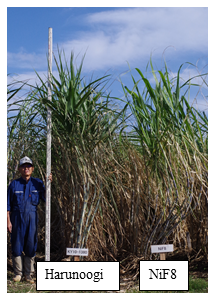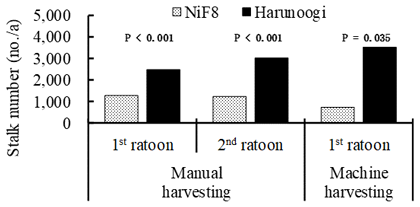Harunoogi, a high ratoon yield sugarcane cultivar developed by interspecific hybridization between sugarcane and Saccharum spontanium
Description
Sugarcane (Saccharum spp. hybrid) is an essential crop for food and energy production, and improvement of its productivity will contribute toward promoting food sustainability and energy security around the world. Sugarcane can continue growing by low-cost cropping type ratooning, whereby the post-harvest stubbles in the fields are regrown. Improving ratoon productivity for high-latitude production areas, where low temperatures cause problems in ratooning, have been one of the most important breeding targets; however, the stagnation of genetic improvement arising from the narrow genetic diversity of cultivars and breeding materials in the world has become an issue in breeding, hence expanding genetic diversity using unused genetic resources is required. The wild sugarcane, S. spontaneum, is an important genetic resource for improving sugarcane ratoon yield due to its superior tillering and ratooning ability under various environments. The aim of this study therefore was to develop a sugarcane cultivar with good tillering ability and high ratoon yield for high-latitude sugarcane production areas by interspecific hybridization between sugarcane and S. spontaneum.
The new high ratoon yield cultivar Harunoogi was developed from a crossing between fodder sugarcane cultivar KRFo93-1 (which was developed by interspecific hybridization between sugarcane cultivar NCo310 and S. spontaneum Glagah Kloet and has excellent tillering ability with high ratoon yield at multiple ratooning) and the high-sugar-content sugarcane cultivar NiN24 (Fig. 1, Fig. 2). Harunoogi can produce an extraordinarily large number of stalks with sugar content comparable to that of NiF8, which is a major cultivar in high-latitude areas in Japan, even though its stalk diameter is smaller than NiF8 (Table 1). Its excellent ratooning ability enables the production of more stalks than NiF8 in ratoon crop, especially after machine harvesting (Fig. 3). As a result, cane yield and sugar yield in 1st and 2nd ratoon crops of Harunoogi are much higher than NiF8’s (Table 1).
Harunoogi, which was jointly developed by the Japan International Research Center for Agricultural Sciences and the National Agriculture and Food Research Organization, is expected to contribute to sugarcane production in high-latitude areas in Japan. Interspecific hybridization with S. spontaneum will be an important strategy toward improving the tillering ability and productivity of ratoon crops in high-latitude areas where low temperature is a critical constraint in sugarcane production.
Figure, table
-
Fig. 1. Harunoogi and NiF8
Photos taken in November 2018 in Nishinoomote, Japan -
Fig. 2. The pedigree of Harunoogi
-
Fig. 3. Stalk number in early growth stage of the ratoon crop
The p-values were calculated by a generalized linear model with cultivar (fixed effect) and plot (random effect). -
Table 1. The agronomic characteristics of Harunoogi
Cropping
typeCultivar Stalk
numberStalk
lengthStalk
diameterSingle stalk
weightCane
yieldSugar
contentSugar
yield(no./ha) (cm) (mm) (g) (t/ha) (%) (t/ha) New planting Harunoogi 143,950 224 20.6 685 97.3 12.4 11.0 NiF8 93,100 244 22.5 818 75.6 12.1 8.4 p-value <0.001 <0.001 <0.001 <0.001 <0.001 0.441 <0.001 1st ratoon Harunoogi 188,667 244 19.4 619 117.2 11.8 12.7 NiF8 110,633 238 20.5 649 71.9 12.4 8.2 p-value <0.001 0.272 0.016 0.337 <0.001 0.098 <0.001 2nd ratoon Harunoogi 192,950 218 19.6 583 109.7 10.4 9.8 NiF8 134,800 215 20.5 558 74.6 10.4 6.7 p-value 0.003 0.733 0.116 0.492 <0.001 0.723 0.003 The experiments were conducted from 2015 to 2018 at Kyushu Okinawa Agricultural Research Center, Tanegashima Sugarcane Breeding Site, Nishinoomote, Japan. The results in the table show the means of 4 years (2015-2018) in new planting, three years (2016-2018) in 1st ratoon, and two years (2017-2018) in 2nd ratoon. The p-values were calculated by a generalized linear model with cultivar (fixed effect), year, and plot (random effect).
- Affiliation
-
Japan International Research Center for Agricultural Sciences Tropical Agriculture Research Front
- Classification
-
技術
- Research project
- Program name
- Term of research
-
FY2019 (FY2009-FY2020)
- Responsible researcher
-
Teraiima Yoshifumi ( Tropical Agriculture Research Front )
Sugimoto Akira ( Tropical Agriculture Research Front )
KAKEN Researcher No.: 30414840Hattori Taiichiro ( National Agriculture and Food Research Organization (NARO) )
Matsuoka Makoto ( National Agriculture and Food Research Organization (NARO) )
Terauchi Takayoshi ( National Agriculture and Food Research Organization (NARO) )
Sakaigaichi Takeo ( National Agriculture and Food Research Organization (NARO) )
Ishikawa Shoko ( National Agriculture and Food Research Organization (NARO) )
Tanaka Minoru ( National Agriculture and Food Research Organization (NARO) )
Tarumoto Yusuke ( National Agriculture and Food Research Organization (NARO) )
Hayano Michiko ( National Agriculture and Food Research Organization (NARO) )
Adachi Katsuki ( National Agriculture and Food Research Organization (NARO) )
Umeda Makoto ( National Agriculture and Food Research Organization (NARO) )
- ほか
- Publication, etc.
-
https://doi.org/10.24514/00003206
Hattori, et al. (2019) Journal of the NARO Research and Development, 2:21-44
- Japanese PDF
-
2019_B06_A4_ja.pdf1.47 MB
2019_B06_A3_ja.pdf252.07 KB
- English PDF
-
2019_B06_A4_en.pdf303.37 KB
2019_B06_A3_en.pdf192 KB
- Poster PDF
-
2019_B06_poster_fin.pdf419.24 KB



